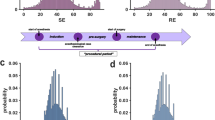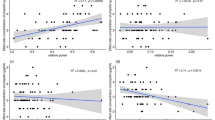Abstract
Permutation entropy (PE) as a complexity measure has been introduced to monitor anesthetic depth for adult. However, PE has not yet been evaluated for its clinical applicability as an indicator of anesthetic depth in children. Therefore, in order to investigate the validity of PE, we compared PE with BIS using pharmacodynamic (PD) modeling in children. Electroencephalogram (EEG) was obtained from BIS monitor during sevoflurane deepening and lightening protocol. End-tidal sevoflurane concentration (Etsevo) and BIS were measured simultaneously. PE was calculated from the processed EEG with the scale ranging from 0 to 100. NONMEM software was used to investigate the PD relationship between Etsevo with BIS and PE. Adjusted PE (APE) values were decreased as anesthesia deepened. APE and BIS showed significant linear correlation (P < 0.001), indicating that PE also reflects anesthesia depth. PD parameters for APE and BIS were estimated with a sigmoid Emax model which describes the relationship between Etsevo and APE/BIS (E o : 78, E max : 17.6, C e50 : 2.5 vol%; γ: 13.1, k eo : 0.47 min−1 for APE; E o : 89.4; E max : 15.7; C e50 : 2.2 vol%; γ: 6.6, keo: 0.52 min−1 for BIS). PE seems to be a useful indicator of anesthetic depth, which is comparable to BIS in children.






Similar content being viewed by others
References
Kreuer S, Biedler A, Larsen R, Altmann S, Wilhelm W (2003) Narcotrend monitoring allows faster emergence and a reduction of drug consumption in propofol-remifentanil anesthesia. Anesthesiology 99(1):34–41
Yli-Hankala A, Vakkuri A, Annila P, Korttila K (1999) EEG bispectral index monitoring in sevoflurane or propofol anaesthesia: analysis of direct costs and immediate recovery. Acta Anaesthesiol Scand 43(5):545–549
Johansen JW, Sebel PS, Sigl JC (2000) Clinical impact of hypnotic-titration guidelines based on EEG bispectral index (BIS) monitoring during routine anesthetic care. J Clin Anesth 12(6):433–443
Heier T, Steen PA (1996) Assessment of anaesthesia depth. Acta Anaesthesiol Scand 40(9):1087–1100
Rampil IJ, Matteo RS (1987) Changes in EEG spectral edge frequency correlate with the hemodynamic response to laryngoscopy and intubation. Anesthesiology 67(1):139–142
Ellerkmann RK, Liermann VM, Alves TM, Wenningmann I, Kreuer S, Wilhelm W, Roepcke H, Hoeft A, Bruhn J (2004) Spectral entropy and bispectral index as measures of the electroencephalographic effects of sevoflurane. Anesthesiology 101(6):1275–1282
Elbert T, Ray WJ, Kowalik ZJ, Skinner JE, Graf KE, Birbaumer N (1994) Chaos and physiology: deterministic chaos in excitable cell assemblies. Physiol Rev 74(1):1–47
Fell J, Roschke J, Mann K, Schäffner C (1996) Discrimination of sleep stages: a comparison between spectral and nonlinear EEG measures. Electroencephalogr Clin Neurophysiol 98(5):401–410
Grassberger P, Procaccia I (1983) Estimation of the Kolmogorov entropy from a chaotic signal. Phys Rev A 28(4):2591–2593
Bruhn J, Ropcke H, Rehberg B, Bouillon T, Hoeft A (2000) Electroencephalogram approximate entropy correctly classifies the occurrence of burst suppression pattern as increasing anesthetic drug effect. Anesthesiology 93(4):981–985
Bruhn J, Ropcke H, Hoeft A (2000) Approximate entropy as an electroencephalographic measure of anesthetic drug effect during desflurane anesthesia. Anesthesiology 92(3):715–726
Bandt C, Pompe B (2002) Permutation entropy: a natural complexity measure for time series. Phys Rev Lett 88(17):174102
Cao YH, Tung WW, Gao JB, Protopopescu VA, Hively LM (2004) Detecting dynamical changes in time series using the permutation entropy. Phys Rev E 70(4 Pt 2):046217
Olofsen E, Sleigh JW, Dahan A (2008) Permutation entropy of the electroencephalogram: a measure of anaesthetic drug effect. Br J Anaesth 101(6):810–821
Li XL, Cui SY, Voss LJ (2008) Using permutation entropy to measure the electroencephalographic effects of sevoflurane. Anesthesiology 109(3):448–456
Constant I, Sabourdin N (2012) The EEG signal: a window on the cortical brain activity. Paediatr Anaesth 22(6):539–552
Jensen EW, Litvan H, Struys M, Martinez Vazquez P (2004) Pitfalls and challenges when assessing the depth of hypnosis during general anaesthesia by clinical signs and electronic indices. Acta Anaesthesiol Scand 48(10):1260–1267
Jameson LC, Sloan TB (2006) Using EEG to monitor anesthesia drug effects during surgery. J Clin Monit Comput 20(6):445–472
Bandt C (2005) Ordinal time series analysis. Ecol Model 182(3–4):229–238
Schnider TW, Minto CF, Shafer SL, Gambus PL, Andresen C, Goodale DB, Youngs EJ (1999) The influence of age on propofol pharmacodynamics. Anesthesiology 90(6):1502–1516
Jonsson EN1, Karlsson MO (1999) Xpose–an S-PLUS based population pharmacokinetic/pharmacodynamic model building aid for NONMEM Comput Methods Progr Biomed 58(1):51–64
March PA, Muir WW (2005) Bispectral analysis of the electroencephalogram: a review of its development and use in anesthesia. Vet Anaesth Analg 32(5):241–255
Goncharova II, McFarland DJ, Vaughan TM, Wolpaw JR (2003) EMG contamination of EEG: spectral and topographical characteristics. Clin Neurophysiol 114(9):1580–1593
Gasser T, Verleger R, Bacher P, Sroka L (1988) Development of the EEG of school-age children and adolescents. I. Analysis of band power. Electroencephalogr Clin Neurophysiol 69(2):91–99
Nunes RR, Chaves IM, de Alencar JC, Franco SB, de Oliveira YG, de Menezes DG (2012) Bispectral index and other processed parameters of electroencephalogram: an update. Rev Bras Anestesiol 62(1):105–117
Rampil IJ (1998) A Primer for EEG Signal Processing in Anesthesia. Anesthesiology 89(4):980–1002
Acknowledgments
We are grateful to all members in Biomedical Knowledge Engineering Lab, Seoul National University, College of Dentistry for their assistance. And we are also grateful to Professor Satoshi Hagihria for providing Bispectrum Analyzer software.
Conflict of interest
The authors declared no conflict of interest.
Author information
Authors and Affiliations
Corresponding authors
Additional information
Teo Jeon Shin and Hong-Gee Kim equally contributed to this study.
Electronic supplementary material
Below is the link to the electronic supplementary material.
Appendix: NONMEM control code
Appendix: NONMEM control code

Rights and permissions
About this article
Cite this article
Kim, PJ., Kim, HG., Noh, GJ. et al. Usefulness of permutation entropy as an anesthetic depth indicator in children. J Pharmacokinet Pharmacodyn 42, 123–134 (2015). https://doi.org/10.1007/s10928-015-9405-5
Received:
Accepted:
Published:
Issue Date:
DOI: https://doi.org/10.1007/s10928-015-9405-5




